A perambulation of Cliftonville
You are invited to join a perambulation - a walk around the boundary - of Cliftonville. This is envisaged as an opportunity to chart a particular and perhaps unexpected path around this place. To see what we notice along the way. To think about Cliftonville as an area, what lies within and without. To think about what all of this means to us, and to share these thoughts, ideas and observations with each other. While this has been organised by Transit Collective, it is intended to be open and participatory: this is your walk!
Saturday 2 August, 10am
RESCHEDULED DATE
2 - 2.5 hours
Meeting on the lawns opposite Forts Cafe, 8 Cliff Terrace, CT9 1RU
There are various definitions for the act of making a perambulation. While the more common use now is that of a stroll, and as such lent its meaning to a child’s pram (orig. perambulator), it stems from the act of marking and remembering the boundary of an area of land, such as a manor or parish. In this way a perambulation is synonymous with the act of ‘beating the bounds’.
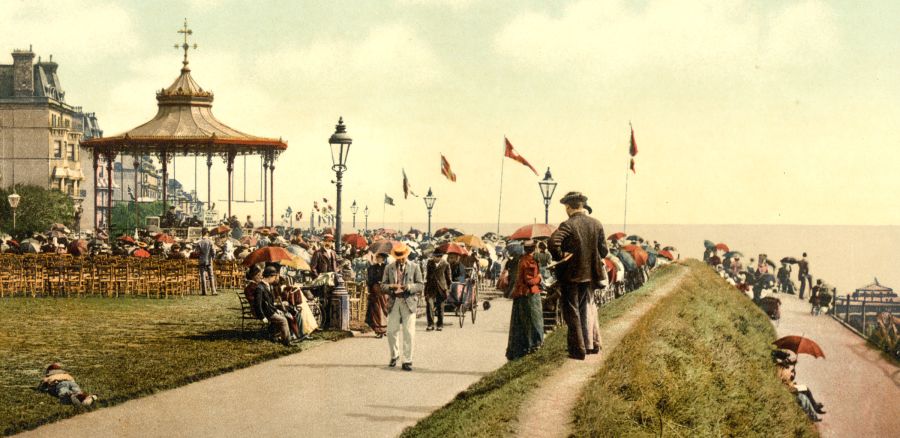
Strolling on the promenade. Lee's Promenade and Bandstand, Folkestone (detail). c1890. Photochrom print.
Before modern, drawn surveys, a perambulation would note landmarks (natural or man made) which were encountered on the route, recorded in writing or committed to the collective memory, often in very performative fashion. This was to ensure that the boundary be maintained and to guard against infringement. As such a perambulation was not only an act of defining a particular area, but also an act of observation. Later perambulations (e.g. around enclosed land) continued the story of performance and also power.
Where and what is Cliftonville?
Cliftonville exists in different ways; as a label on maps, at a civic level, and most importantly in the minds and memories of people who live and visit here.
Cliftonville, located east of Margate’s center, is defined in civic terms by the Thanet District Council wards of Cliftonville East and West, whose current boundaries are used for this walk. These wards fall within the former Borough of Margate (at its 1974 dissolution). Margate’s development eastwards was concentrated in the period 1850-1870. Described first as Margate New Town and subsequently as Peel Town, it was apparently the developers of the Cliftonville Estate who were behind the use of the name for the area, and this can be seen on maps from the 1890s, appearing elsewhere as early as the 1860s. By 1907 there was a Cliftonville ward, which extended to what is now the easternmost edge of Cliftonville East by the 1930s.
It is thought Cliftonville may owe its name in homage to the large estate of the same name in fashionable Brighton developed in the 1840s. Local precursors include the Clifton Baths (now Lido) opened in 1828. Clifton and Cliff feature as various street names in the East of Margate established prior to 1850 and the etymology of the name makes sense here.
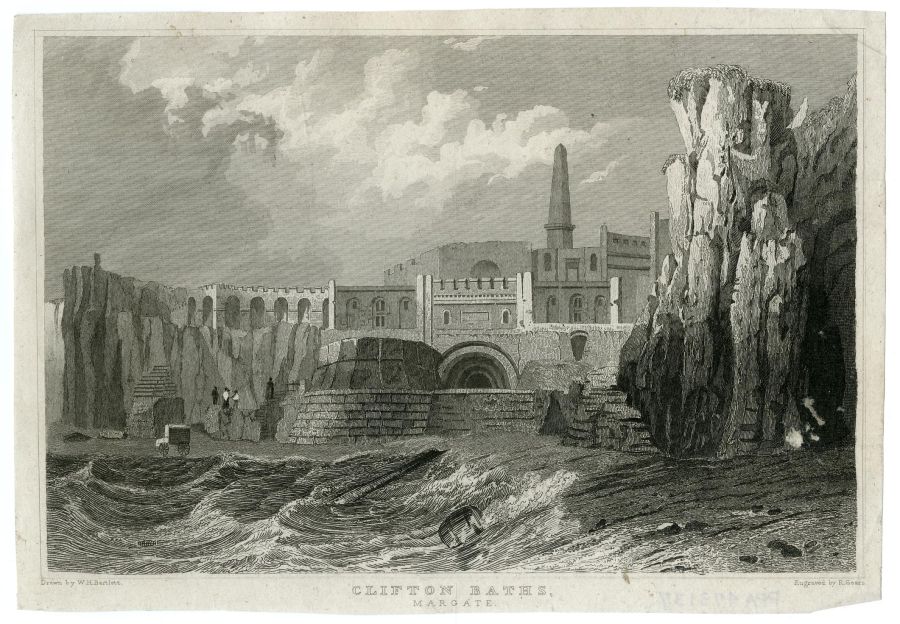
Clifton Baths, Margate. Etching and engraving on chine collé. Drawn by W. H. Bartlett / Engraved by R. Sears. 1824/1854 © The Trustees of the British Museum. Shared under a Creative Commons Attribution-NonCommercial-ShareAlike 4.0 International (CC BY-NC-SA 4.0) licence.
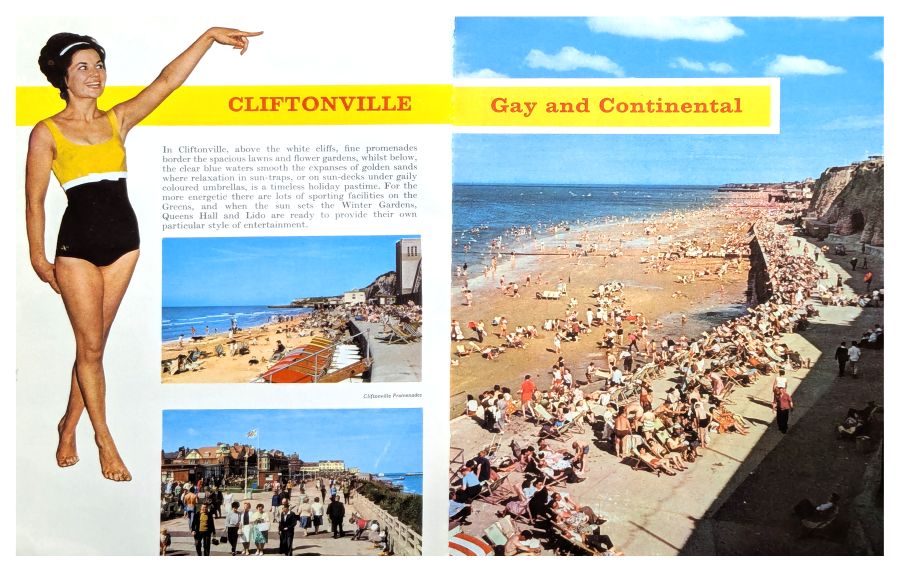
Tourist guide to the Isle of Thanet from c.1970
Boundaries shift
Different civic organisations, cartographers and individuals have their own ideas about the boundaries of any given area. The current boundary of the wards of Cliftonville East and Cliftonville West are subject to minor changes currently being consulted on by the boundary commission. If the proposed changes are enacted additional streets will be brought into Cliftonville West from Margate Central & Dane Valley. Whatever the outcome, any change is due to take effect for elections in 2027.
More broadly, Kent’s local government is undergoing significant changes. Currently, Kent (excluding Medway) operates on a two-tier system, with a county council, district councils, and some town/parish councils. The government has requested proposals from the county and district councils to establish a new system of unitary councils across Kent. While these proposals are not yet finalised, initial indications suggest a structure reminiscent of Kent’s historical Lathes system. This unique arrangement, which originated with the Jutish settlement in the 5th century and persisted until the 19th century, divided the county into five administrative divisions.
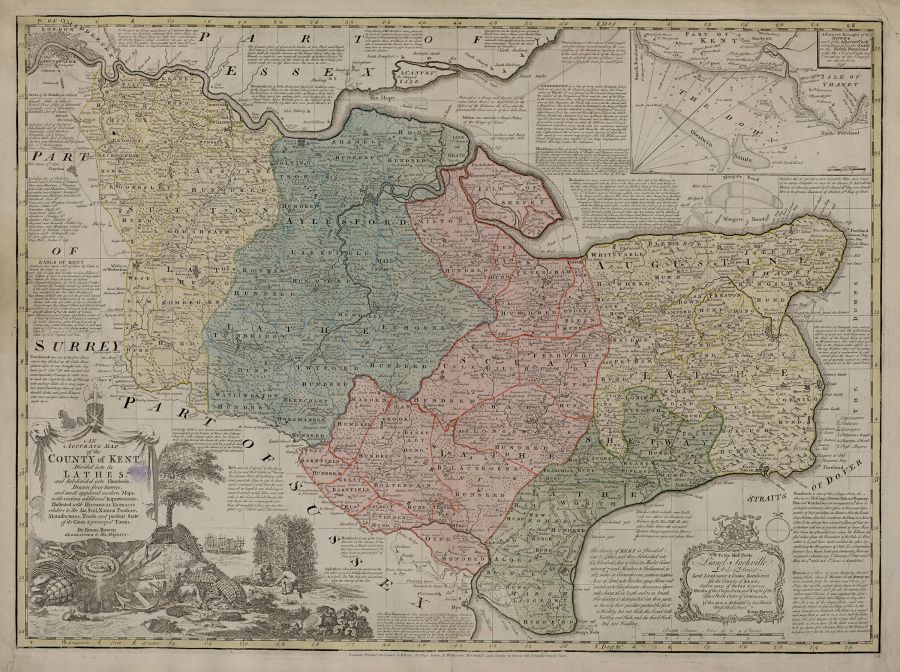
An Accurate Map of the County of Kent Divided into its Lathes and Subdivided into Hundreds. 1775-1795. Emanuel Bowen. National Library of Spain (CC BY-NC-SA).
Meanwhile individual and commercial notions of the boundary change, responding to public perception, fashion and media. 10 years ago when Cliftonville was considered by many to have less positive connotations, estate agents would extend the boundary of the old town and enlarge the notion of Palm Bay. This is not a ward, but the area in the east of Cliftonville East - considered part of Cliftonville when developed, but seen as distinct by many more recently.
The perambulation group
Depictions of early 19th century perambulations often show the procession being led by a beadle (a lay official of the parish or manor) and typically with a priest in attendance. Sometimes they seem to have included a wide range of people, including children, and been quite chaotic affairs, others appear more formal with a list of dignitaries present.
We will be guided by a temporarily installed Cliftonville Beadle and we can make this as chaotic as we like …
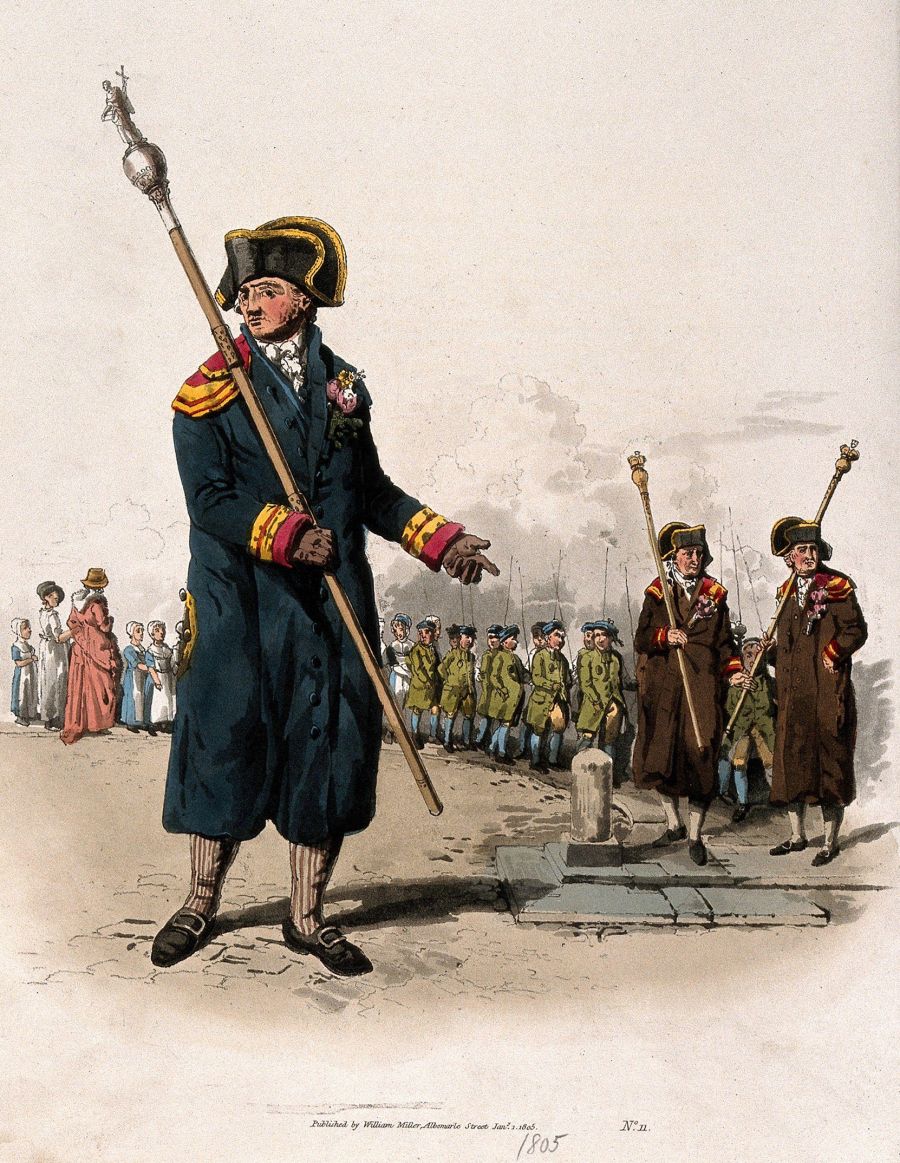
A beadle, carrying his staff: behind him two churchwardens lead a procession of orphans of the parish, the boys carrying wands to beat the bounds. Coloured aquatint by W. H. Pyne, 1805. Wellcome Collection. Source: Wellcome Collection.
Beating, boundary markers and perambulation mementos
Beating the bounds is the act of swatting landmarks passed on the perambulation, reinforcing their commitment to memory. Apparently this was often done by the young boys in the party, using green sticks of birch or willow. Looking further afield - there’s a very long tradition of physical boundary markers in various parts of the world, and a much more recent tradition of signs which welcome the traveller into a settlement.

Boundary token for Gateshead ©The Trustees of the British Museum (CC BY-NC-SA 4.0)

Twin Peaks. 1990–1991. Lynch/Frost Productions.
Some of the more formal C19th perambulations often left participants with a token to mark the occasion. The enclosed stickers are our token to remember this walk.
We may or may not have boughs of green birch, but will find our own ways to mark this boundary as we walk it, eyes open to whatever we might discover along the way.
Belonging, identity and the other
The act of beating the bounds has meaning for the community within. The parameters of the perambulation, such as who leads the procession, the people present and the landmarks identified & observations made change the social and political meaning of the perambulation. Who holds power within the community and what do they identify as important?
The very notion of geographical boundaries can be used as a way to give safety and belonging to the community within. However, the meaning of the boundary can easily change its emphasis to one of protecting the inhabitants from perceived threats from those beyond the boundary. We appear to be living in a time when boundaries of communities, countries and even individuals are thought of as protecting those within from those without. In psychological terms though, boundaries are generally more helpful when flexible and focused on the needs of those within, rather than rigid and impermeable.
We hope this is a chance for you to express your own relationship with this place and your understanding of it, and to share that, as much as you feel happy to, with the group.